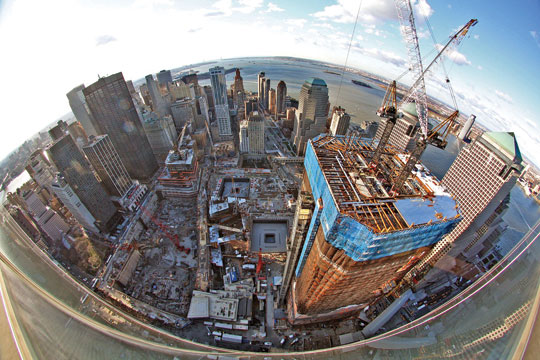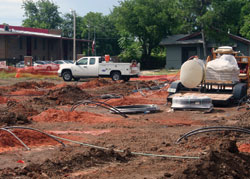Renovating for a Greener, More Accessible Future
The same holds true for architectural products that boost the performance of buildings with little or no adaptation. These qualities make them more widely applicable to historical adaptive reuse and other renovations — the “whole-building recycling projects” that currently make up the lion’s share of green building work.
| High-Rise Structure, Low Carbon Impact | ||
A number of new building projects and renovations have pointed to novel structural and precast concrete systems that limit the use of Portland cement, which may make up as much as 9% of all carbon emissions in the world, says U.S. Concrete’s Wally Johnson. A growing trend is that building product manufacturers will often provide the carbon footprint of their products or structural systems. Smaller carbon footprints reflect both operational process and the use of materials, such as alternative cementitious products, that reduce greenhouse gasses. Recent projects include One World Trade Center, part of the new World Trade Center complex in New York City. A hybrid structural design created by architect David Childs of Skidmore, Owings & Merrill with the local structural engineer WSP Cantor Seinuk, the building employs steel and concrete structural columns as well as innovative concrete core walls with steel frames for lateral force resistance and other security needs. The concrete mix uses a proprietary mix as well as an admixture optimization service by another supplier that determines the optimal combination of recycled materials and tailor-made chemical admixtures needed to improve the desired slump, setting characteristics, strength and durability of concrete used. The results of the approach include two high-strength core wall mixes that exceed project requirements. Beyond the enhancements to the strength and durability of the concrete structure, the combined technologies are credited with a significant change in the project’s environmental profile: The optimized mix has saved more than 30,000 gallons of fresh water, 8 million kWh of energy and nearly 750,000 pounds of fossil fuel. According to Johnson, the carbon footprint is smaller by at least 12 million pounds of CO2 emissions as compared to what would have been required for a similar high-strength, hybrid high-rise. Other LEED Platinum projects are also using concrete mixes meant to dramatically cut carbon emissions, says Johnson. One example is the Trinity River Audubon Center in Dallas, designed by Antoine Predock Architect of Albuquerque, N.M., with architect-of-record Brown Reynolds Watford Architects of Dallas and the local engineer Lopez Garcia Group. Designed for LEED Gold certification, the center is built to meet its mission of people, forest, river and wildlife coexisting successfully. Part of that mission is built into its 10,026 cubic yards of low-carbon concrete mix, comprising 30% fly ash and 50% pier mix; the outcome is the avoidance of at least 1.8 million pounds of CO2.
|
| Geothermal for Nonprofit Headquarters | ||
For a renovation of the charitable group United Way’s headquarters for Central Oklahoma, the local firm of HSEarchitects used metal cladding and a perforated aluminum panel system to update the organization’s image. Costing about $3 million, the updating of the 28,000-square-foot facility combined the distinct historic characteristics of a 1911 church with contemporary commercial office space. Low maintenance was one goal, according to the architects, as was a high level of accessibility through multiple entrances. A new canopy structure identifies the main, universally accessible entry.
To reduce energy use, the design-build project includes low-E glazing and exterior sun shading on south and west façades. “In keeping with sustainable solutions and forward thinking, a geothermal system was installed with 25 wells located beneath the new parking lot,” according to the architects. According to ClimateMaster’s Bailey, the dozens of heat pumps match the need for environmental zones within the building. Vertical packaged units are located in small mechanical closets or the basement and draw from 63 vertical bores of about 300 feet deep using steel/copper piping and variable-speed pumping. The geothermal engineering, Bailey adds, helped keep the costs at a reasonable level, including: the geothermal installation (about $630,000), the water loop with a fluid cooler and boiler ($542,000), the 23-zone fan coil with air-cooled chiller and boiler, as well as rooftop makeup air units ($617,000), and 16 new gas/electric rooftop units and three split systems ($400,000). |
| Renovations for Whole-Building Recycling | ||
One effective way to reduce carbon emissions is through the use of existing structures that can be renovated for better function or for adapting to other uses. According to the AIA’s Committee on the Environment, “by 2035 more than a third of the built environment will exist in the form of new renovation projects. In reversing the climate change crisis, this is a key opportunity to avoid otherwise demolishing more than 25% of our building stock and instead promoting adaptive reuse design.” For Abington Senior High School in Abington, Pa., the firm AP3C Architects of Philadelphia, reinvention of the modernist brick school building was envisaged to support its vision of providing an excellent community for young people that would increase success in school and prepare students for life outside of school. A major part of the renovation was the need for new, thermally broken projected windows to match the original frame depths, sightlines and infill thicknesses. The thermal barrier in the windows’ vents and frames would also help meet the school’s desired performance ratings and energy conservation goals. Also, to improve access to the school while maintaining standards for security and code-mandated egress, AP3C Architects selected a commercial-duty replacement package of wide-stile doors that would provide maximum flexibility for hardware as well as student needs and administration uses. Testifying to the success of the renewed three-year high school, last October the Abington school district received a “100 Best Communities for Young People” award — the fifth it has received — as part of a competition that recognizes communities taking action to help reduce local dropout rates and create better futures for young people.
|
Notice

www.us-concrete.com/aridus
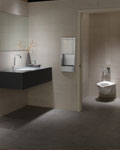
www.totousa.com

www.Nanawall.com
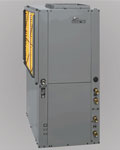
www.climatemaster.com
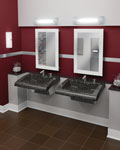
www.bradleycorp.com
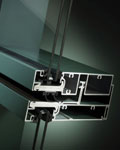
www.efcocorp.com





